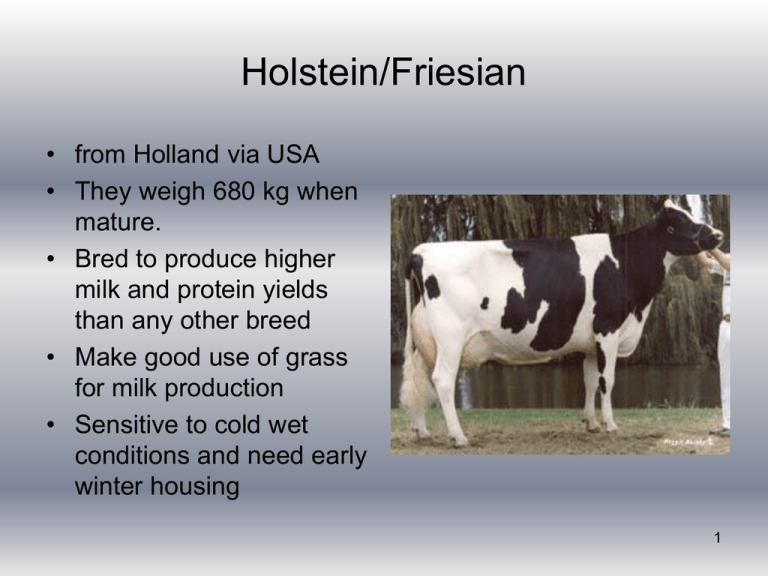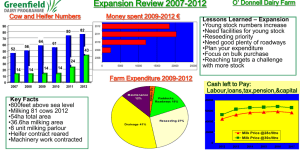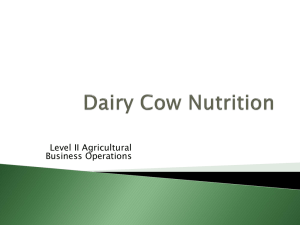File
advertisement

Holstein/Friesian • from Holland via USA • They weigh 680 kg when mature. • Bred to produce higher milk and protein yields than any other breed • Make good use of grass for milk production • Sensitive to cold wet conditions and need early winter housing 1 British Friesian • Slightly smaller than Holsteins • Carry more flesh • Good fertility 2 Other Dairy Breeds Ayrshire • Easy calving and longevity 3 Brown Swiss • Longevity • Good feet and legs • Strong and healthy 4 Guernsey • Efficient converter of feed to milk • Early maturity • Milk is a distinctive golden colour. • Easy calving 5 Jersey • Milk is high and fat and protein but lower yield than Holstein-Friesian • Low maintenance cost • Easy calving • High fertility • Longevity • Less prone to lameness 6 Milking Shorthorn • red, red and white, white or roan, a very close mixture of red and white, and found in no other breed of cattle. • Ease of calving • Good feet • Longevity 7 Montbéliarde • Light red and white, white head • Dual purpose • Hardy • Resistance to mastitis 8 Norwegian Red • Calving ease • High fertility • High fat and protein milk • Higher Mastitis resistance • Choice of Polled or Horned • Hardy hooves 9 Normande • Dual purpose • Good growth rate in calves • Ideal for dairy crossbreeding • Fertility • Calving ease • Strength • High percentage yield at slaughter 10 Jersey X Holstein cross • Smaller, lighter and darker in colour than Holstein • Lower milk volume • Higher milk solids • Efficient converter of grass 11 12 Age (yr) Lactation no. Lactation yield as % of maximum 2 1 75 3 2 85 4 3 90 5 4 95 6 5 100 Cows produce first calf at 2 years. Reach maximum yield at their fifth lactation 13 Breeds of cattle – contrast in milk composition (%) Breed Milk (kg) Fat (kg) Protein (kg) % fat Jersey 4797 243 180 5.06 Holstein/ 6970 Freisian 264 234 3.79 14 Lactating • When lactating a cow can be either pregnant or non-pregnant. • When dry pregnant. • Try to get the cow to complete the cycle in one year. • The length of the cycle depends on how long it takes for her to get pregnant again. 15 1 year calving interval • 305 days of lactation • 60 days of a dry period • Cow carries calf for 9 ½ months (283-286 days) • 365 – 286 = 82 days • Need to be mated 82 days after calving • If it goes over 82 days, it will go over the 1 year cycle. 16 Lactation curve of a machine milked cow Milk yield Early lactation Mid lactation Late lactation Dry period 0 weeks: calving These changes are due to changes in activities and changes in the number of cells in the mammary glands 17 Milking machine versus cow with calf • Yield is in response to a challenge • More milk asked for more milk will be provided Milk yields/ day (Kg) Milk machine Cow with calf Time (months) 18 Factors influencing milk yield • Breed, weight at calving • Age • Frequency of milking • Dry period 19 Factors influencing milk composition • Breed • Feed – Good grass increases milk, fat and protein – Fibre needed for fat production • Stage of lactation • Milking interval 20 Feeding for milk quality • • • • High fibre feed increases butterfat content Leafy grass increases protein Good quality feed Control mastitis 21 Grass Budgeting • A grass budget aims to balance the grass supply with the grass requirement or "herd demand". • Measure grass cover • Estimate DM cover and grazing requirement 22 Estimating Grass Cover 23 24 Grass Budgeting 25 26 27 Grass budgeting • Example – A farmer has 50 cows grazing on a 0.5 ha paddock. Each cow consumes 15 kg DM/day. How long can the cows be left in the paddock to graze it completely? (i.e. a stubble height of 4 cm). 28 • • • • • • • • Mass of grass removed from a 0.25 m2 quadrat = 200 g DM = 18% 200 g x 0.18 = 36 g DM or 0.036 kg DM/0.25 m2 0.036 kg DM x 4 = 0.144 kg DM/m2 0.5 ha = 5000 m2 0.144 kg DM x 5000 = 720 kg DM/0.5 ha 720/50 = 14.4 kg DM/cow At 15 kg DM intake/day, (14.4/15) x (100/1) = 96% of their daily intake • 24 hours x 0.96 = 23.04 hours • 23 hours grazing left 29 Milk Quality Standards 2. Somatic Cell Count (SCC): – Count of white blood cells – High SCC indicates presence of sub clinical mastitis – SCC must mot exceed 400,000 on a three month geometric mean http://www.fsai.ie/uploadedFiles/Reg853_2004(1).pdf 30 Milk Quality Standards 3. Thermoduric Test: – Number of thermo-resistant bacteria must not be > 1000/ml 4. Milk temperature: – Milk only collected from refrigerated tanks and be < 6°C 5. Antibiotic test – Routine test for the presence of antibiotics http://www.fsai.ie/uploadedFiles/Reg853_2004(1).pdf 31 Milk Quality Standards 6. Excess water: 7. Sediment test: – Milk must be free from physical particles and sediment – Cow’s udders and teats must be clean at milking time and milk filtered – Biosecurity for diseased animals http://www.fsai.ie/uploadedFiles/Reg853_2004(1).pdf 32 The Milking Machine • Extracts milk from the cow by vacuum. • Apply constant vacuum to the end of the teat to suck the milk out, convey it to a suitable container, to give a periodic squeeze applied externally to the whole of the teat to maintain blood circulation. • A milking machine installation consists of a pipework system linking various vessels and other components which together provide the flow paths for air and milk. • The forces are maintained by a vacuum. • Atmospheric pressure forces air, and intra-mammary milk pressure which forces milk, into the system and the combination of these forces causes flow. • continuous operation 33 Cluster • Part of the machine which is attached to the cow • Claw piece and four teat cups • Connected to the bucket, milk cup or recorder jar via a milk tube • Can be removed automatically 34 Herringbone Parlours • Cows stand in echelon formation at 30°–35° to the operator's pit with no division between cows. • Distance between udders is reduced to 0.9 m. • Operator has control over cow entry/exit • Cows enter and leave in batches. Suitable for herds of 50–400 cows 35 Side by Side • Modification of the herringbone. • Cows stand at right angles to the operator's pit, so that 3 cows occupy the length required for 2 in the herringbone. • Cows must be milked through the back legs. 36 Rotary Tandem • Most expensive per cow place in terms of cost and space requirement. Cows stand nose-to-tail in stalls circling the operators work area. Operator cannot assist cow entry but can see all cows easily during rotation. • 250 cows plus 37 Annual Cycle in Dairying • Day 0 Cow calves - begins to lactate • Lactation 305 days • Dry period 60 days • Ideally 365d calving interval- but more often closer to 400 days • As with suckler cow if to have 365d calving interval need to conceive 80-86 days post calving as gestation length is on average 278283 days • Aim to serve cow 56 days post calving 38 Planning 1. Plan calving dates (includes both cows and heifers) • Herd with mean calving date c. Feb 15th (first cow calving c. Jan 20th) has highest potential profits– Higher milk yield – Increased grass consumption and reduced silage consumption when compared to herd calving in Aprilreduced costs • Mean calving date in Ireland is March 16th 39 Requirements for Replacements in Dairy herd • 17% rate of replacements ideal – i.e. 17 cows culled from 100 cow herd every year with 17 new heifers required • Average replacement rate in Ireland is 27% – 40 Replacement Heifers: Age at Service and First Calving • At first service heifers should weigh approx. 2/3rds of final mature weight = 400kgs – c. 15 months – Calving at c. 24 months – dystocia if calving before 22 months – Fit in with calving pattern of herd • Choice of bull – Usually use breed Aberdeen Angus or Hereford- less calving problems than Friesian – Variation within breeds- ‘Easy calving bull’ • BCS 3- 3.5 6-8 weeks pre calving 41 Diseases of Dairy (and Suckler) Cows • • • • • • • Brucellosis Mastitis Milk Fever Ruminoacidosis and Ketosis Grass staggers Lameness - Foot Problems Bovine Spongiform Encephalopathy (BSE) • Johnes Disease 42 Brucellosis • • • • ZOONOSIS - undulant fever in humans HIGHLY INFECTIOUS Caused by bacterium Brucella abortis Causes abortion –usually 5-7th month of pregnancy • Non-pregnant animals can act as carriers 43 Brucellosis • All breeding cattle (cows and bulls) in Ireland must be tested for brucellosis - blood test – All females over 1 year – All bulls over 2 years old – After 30 days movement test required • Animals that are found positive for brucellosis are slaughtered • Treatment of affected animals is not appropriate 44 Mastitis • Bacterial disease of the udder • Infection gains access to gland via teat 1. Dirty housing conditions (pre and post calving) 2. Poor hygiene during milking 3. Damage to teat sphincter due to inconsistent/ excessive vacuum in milking machine 45 Mastitis • Only 1% of cases are noninfectious • Bad hygiene, flies, teat lesions etc. can increase suceptibility • Up to 20 bacteria responsible for mastitis in cows • Including: – – – – E.coli Streptococcus Staphlococcus Pseudomonas 46 Mastitis • 2 forms: – Clinical – signs and symptoms of disease observed- fever, visible alteration in milk etc. – Subclinical – alteration in milk- increased cell counts and bacteria present • Usually chronic infections • Eg. Staphlococcus aureus 47 Swollen, gangrenous udder of ewe with mastitis. Top of a strip cup showing clots and serous milk from a cow with acute mastitis. Brown Swiss heifer with swollen rear gland with mastitis 48 Mastitis: Treatment • Clinical mastitis is treated with intramammary antibiotics • Milk from treated cows must be discarded/ fed to calves – Penalties for selling milk contaminated with antibiotics 49 Milk Fever (parturient hypocalcaemia) • Misnomer! No fever- reduced temperature usually! • Metabolic disorder – Subnormal levels of blood calcium – Sudden production of large volumes of milk (rich in calcium) – Blood calcium levels fall and body stores of calcium (in bones) cannot make up shortfall fast enough • 50 Milk fever cont. • Milk fever usually seen at time of calving up to 10 days post calving (most commonly 24-48 hrs post calving) • High yielding cows usually in 3rd or 4th lactation at greatest risk • Genetic link? – Jerseys > friesians 51 Milk fever: Treatment • Urgent treatment required – Monitor recently calved cows • Sit up to prevent bloat- prop up with bales etc. • Warm bedding and shelter if possible • Inject warmed Calcium borogluconate under skin – Other minerals (Mg and Phosphorus) often also deficient -combined mineral solution usually administered 52 Milk fever: Treatment • Staggering cows should recover in 1 to 2 hours post treatment • Vet consulted if ‘down’ and/or no response in 2 hours • Remove calf/ do not milk (or only partially milk) for at least 48 hours 53 Ruminoacidosis • Overfeeding concentrate ration– disturb ruminal function and normal microbial flora • Results in very high levels of lactic acid and low pH in rumen 54 Ketosis • • • • • Like pregnancy toxaemia in ewe Metabolic condition Usually in peak lactation Energy imbalance High demand for glucose- appetite/ intake cannot provide enough for high yielding dairy cow 55 Ketosis • Number of effects in body of this energy imbalance – Gluconeogenesis- production of ketone bodies- acidic – Breakdown of body fat reserves- fat may be incompletely oxidised (due to low availability of glucose) and may lead to fat deposition in liver- fatty liver 56 Grass Staggers (‘Tetany’) • Metabolic disorder due to subnormal blood levels of magnesium – Hypomagnesaemia – Beef cattle, calves as well as both dairy and suckler cows 57 Grass Staggers (‘Tetany’) Predisposing conditions • Can occur at any time of year when Mg in diet is low • Most common occurrence of ACUTE diseasewhen cows turned out to lush, heavily fertilized grass – Such grass is often deficient in Mg • Can be aggravated by recent calving or cold weather • Soil type can predispose 58 Grass Staggers (‘Tetany’) Symptoms • • • • Nervousness Muscle tremors Twitching eyeballs Muscle spasms, coma and death can rapidly follow - i.e. an emergency • Sudden death 59 Grass Staggers (‘Tetany’) Prevention and treatment • Prevention: – Calcined magnesite (MgO) can be added to diet (60g /head /day) 2-3 weeks before turnout on lush pastures – Continue to feed or a period after turnout • Treatment – Prompt Vet attention- intravenous magnesium 60 Lameness • Common problem • Wear and tear – Long periods on slats – Poor roadways for dairy cows (sharp stones, uneven surfaces etc.) – Poor conformation • Bacterial infections can occur 61 Bovine Spongiform Encephalopathy (Mad Cow Disease) Neurodegenerative Disease of cattle • Transmissible spongiform encephalopathy • Infectious agent is a prion protein • Causes spongy degeneration of brain • Symptoms: • Nervous symptoms in affected cattle- inability to stand and dementia Control measures in Ireland and EU • Notifiable • Slaughter policy Nervous tissue from spinal cord removed from carcase • All animals over 30 months slaughtered must be tested • All casualty animals over 24 months must be tested 62 Other Transmissible Spongiform Diseases • Similar disease in sheep- Scrapie – Fatal, non curable disease of sheep first noted in 18th century – Nervous symptoms – Itching, lip smacking and hopping gait (see video clip), progressive ill thrift and wasting – Breeding programme using sheep with genetic resistance to this disease- sheep blood sampled • Consumption of infected meat products assoc. with development of variant Creutzfeldt-Jakob Disease (vCJD) in humans– different to ‘classical’ CJD – 165 humans have died to date in UK as a result of vCJD Sheep with scrapie may scrape hindend and nibble at fleece. Upper image shows sheep with nervous symptoms and wasting 63 Dairy farm cleaning operations • Milk of low bacterial count (20,000/ ml) requires a relatively consistent high standard of hygiene. • Good keeping quality to store on farm at 4C for 3 days. • Contamination from improperly cleaned equipment can raise the bacterial count to more than 100,000 per ml of milk immediately after milking. • Inferior keeping quality. • Levels of cleanliness depend on : – – – – Type of cleaning product Water quality Method of cleaning Equipment to be cleaned 64 • Detergents are necessary to clean milking and ancillary equipment effectively before disinfection. Effectiveness is increased with solution temperature, concentration and time of application. Bulk tank iodofor detergent 65 Detergents • Increase the 'wetting' potential over the surfaces to be cleaned, • Displace milk deposits, • Dissolve milk protein, • Emulsify the fat • Aid the removal of dirt. 66








